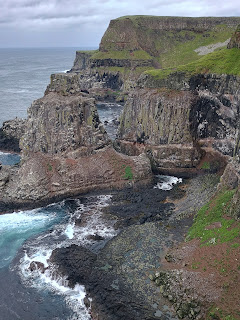Not much local to report but here's an update from a family holiday in Menorca. As this was not a birding holiday I set a low bar of yellow-legged gull so anything else would be a bonus. As it turned out that was a good call as Menorca is not as good for birds as its larger neighbour. Having said that we were at the very southern tip in Punta Prima and didn't get to the north at all. The other issue was the date we were there, early October is well past migration time. There are two bird sites mentioned in Menorca, one was the coastal strip east of Punta Prima, the other one is the Albufeira Es Grau reserve which is a proper reserve with a visitor centre and hides.
Birding in and around the hotel, beach and resort turned these birds up on a daily basis - woodpigeon, collared dove, yellow-legged gull, Audouin's gull, house sparrow, goldfinch, Sardinian warbler, turnstone, cormorant, robin and swallow. I also added blackbird, linnet, stonechat, kestrel and chiffchaff during the week. Merlin proved useful when I heard a calling bird near the hotel and it was identified as a Sardinian warbler. I was able to locate it in a pine tree and was also able to recognise the call during the rest of the holiday.
 |
| Yellow-legged gull |
.JPG) |
| Audouin's gull |
.JPG) |
| Audouin's gull |
.JPG) |
| Turnstone |
.JPG) |
| Turnstone |
We did a trip to the capital Mahon and a boat trip round the harbour - the largest in the western Mediterranean - which is why the island was fought over by the French, Spanish and British on a regular basis. This added shag, rock dove and a very unexpected osprey circling up over the port and being harassed by yellow-legged gulls which is why I picked up on it.
We also visited the Es Grau reserve for a morning. This needed a bus into Mahon and a taxi to the reserve. There are three walks and we did one completely and half of another. We baulked at the second half when we realised it involved a steep descent and then a steep climb to a viewpoint which was then reversed on the way back. It was hot and we were tired so we kept that for another visit! It also took us away from the lake area. The third walk was on the far side of a long inlet (2 mile walk!!) and as we had no transport to reach it we gave it a miss. It was well worth the effort to get to the reserve as we had all the common species plus a few bonus birds. The day list ran to 26 and included black-necked grebe (6), little grebes, great crested grebes, coot (200+), pochard, mallard, grey heron, little egret, great white egret (4), blackcap, Sardinian warbler, Cetti's warbler, raven and moorhen. There were also excellent views of red kites (4), 2 booted eagles soaring over the reserve, 21 flamingos and a tortoise!!
.JPG) |
| Flamingos |
 |
| Tortoise |
 |
| Tortoise, unlike the birds it didn't spook when we approached it!! |
 |
| Es Grau reserve views |
The coastal walk east and west from Punta Prima was on a very rough path where you had to watch your feet rather than the birds. Any likely candidate usually shot straight into the middle of a handy bush, nothing sat up to be looked at. The shoreline was rocky with a small tidal range so there aren't a lot of birds as there is no food. The scenery was lovely but the birding was limited. I did an early morning walk seeing as sunrise was 0800 so it wasn't a chore, but apart from stonechat and two chiffchaffs there was nothing else of note except a nice sunrise.
 |
| Torre del Alcafaur |
 |
| The dodgy path lined with bushes for passerines to dive into |
 |
| Watch your feet not the skies!! |
 |
| Torre del Punta Prima |
 |
| Punta Prima by day |
 |
| Punta Prima by night |
 |
| Sunrise |
 |
| Sunrise |
Obviously the local patches haven't moved but the 2025 list took a little leap up.
2025
146: Audouin's gull
147: Yellow-legged gull
148: Sardinian warbler
149: Booted eagle
150: Osprey
151: Rock dove
152: Black-necked grebe
153: Flamingo













.JPG)
.JPG)
.JPG)
.JPG)
.JPG)






































